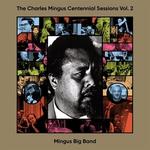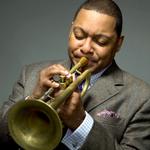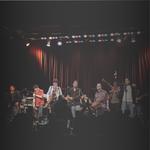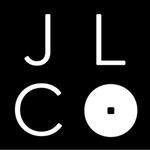
Mingus Big Band Tour Dates and Upcoming Concerts
Welcome to the official artist page for Mingus Big Band – your premier destination for
the latest concert tickets, tour announcements, and exclusive shows near you. Dive into
the music, explore the artist’s reviews and photos, and never miss another concert
moment. Stay updated, stay connected, and be the first to grab tickets for an
unforgettable musical experience.
On tour
Yes
Followers
6,324
Category
Big Band, Jazz, Mingus Music
Concerts
Jan
27
Birdland
New York
Tickets
Jan
28
Birdland
New York
Tickets
Jan
29
Birdland
New York
Tickets
Jan
30
Birdland
New York
Tickets
Jan
31
Birdland
New York
Tickets
Feb
14
Mingus Big Band at Joe's Pub (Sat 7:30pm set)
New York
Tickets
Feb
14
Mingus Big Band at Joe's Pub (Sat 9:30pm set)
New York
Tickets
Feb
15
Mingus Big Band at Joe's Pub (Sun 7:30pm Set)
New York
Tickets
Feb
15
Mingus Big Band at Joe's Pub (Sun 9:30pm Set)
New York
Tickets
About Mingus Big Band
MINGUS BIG BAND bio:
“The hippest big band in the universe - robust, earthy, sanctified.”
— Time Out New York
Mingus Big Band performs exclusively the music of composer/bassist Charles Mingus who celebrated his Centennial year in 2022. Building off the strengths of Mingus Dynasty septet Sue Mingus formed after Mingus’ death in 1979, and 1989’s Epitaph orchestra, in 1991 she created this 14-piece band to feature new arrangements of Mingus compositions in a larger band format that Mingus wanted, but was not always able to organize in his lifetime. The dynamic structure encourages deep explorations and ever-evolving ideations of Mingus Music and provides a platform for individual artistic expression.
Drawing from a rotation of the best established and rising musicians, Mingus Big Band is highly sought-after by festivals and prestigious venues around the world. The band has twelve recordings to its credit, seven nominated for Grammys, and one win in 2011 with Live at Jazz Standard. A new album, The Charles Mingus Centennial Sessions, was released in October 2022 and nominated for a Grammy. The second volume will be released in 2024.
The band has become a New York institution for locals and tourists alike, with a weekly residency now in its fourth decade. From Thursday nights at Fez under Time Cafe, to Joe’s Pub, Iridium, and landing finally at Mingus Mondays at Jazz Standard.
Charles Mingus – Biography
One of the most important figures in twentieth century American music, Charles Mingus was a virtuoso bass player, accomplished pianist, bandleader and composer. Born on a military base in Nogales, Arizona in 1922 and raised in Watts, California, his earliest musical influences came from the church– choir and group singing– and from “hearing Duke Ellington over the radio when [he] was eight years old.” He studied double bass and composition in a formal way (five years with H. Rheinshagen, principal bassist of the New York Philharmonic, and compositional techniques with the legendary Lloyd Reese) while absorbing vernacular music from the great jazz masters, first-hand. His early professional experience, in the 40’s, found him touring with bands like Louis Armstrong, Kid Ory and Lionel Hampton.
Eventually he settled in New York where he played and recorded with the leading musicians of the 1950’s– Charlie Parker, Miles Davis, Bud Powell, Art Tatum and Duke Ellington himself. One of the few bassists to do so, Mingus quickly developed as a leader of musicians. He was also an accomplished pianist who could have made a career playing that instrument. By the mid-50’s he had formed his own publishing and recording companies to protect and document his growing repertoire of original music. He also founded the “Jazz Workshop,” a group which enabled young composers to have their new works performed in concert and on recordings.
Mingus soon found himself at the forefront of the avant-garde. His recordings bear witness to the extraordinarily creative body of work that followed. They include: Pithecanthropus Erectus, The Clown, Tijuana Moods, Mingus Dynasty, Mingus Ah Um, The Black Saint and the Sinner Lady, Cumbia and Jazz Fusion, Let My Children Hear Music. He recorded over a hundred albums and wrote over three hundred scores.
Although he wrote his first concert piece, “Half-Mast Inhibition,” when he was seventeen years old, it was not recorded until twenty years later by a 22-piece orchestra with Gunther Schuller conducting. It was the presentation of “Revelations” which combined jazz and classical idioms, at the 1955 Brandeis Festival of the Creative Arts, that established him as one of the foremost jazz composers of his day.
In 1971 Mingus was awarded the Slee Chair of Music and spent a semester teaching composition at the State University of New York at Buffalo. In the same year his autobiography, Beneath the Underdog, was published by Knopf. In 1972 it appeared in a Bantam paperback and was reissued after his death, in 1980, by Viking/Penguin and again by Pantheon Books, in 1991. In 1972 he also re-signed with Columbia Records. His music was performed frequently by ballet companies, and Alvin Ailey choreographed an hour program called “The Mingus Dances” during a 1972 collaboration with the Robert Joffrey Ballet Company.
He toured extensively throughout Europe, Japan, Canada, South America and the United States until the end of 1977 when he was diagnosed as having a rare nerve disease, Amyotropic Lateral Sclerosis. He was confined to a wheelchair, and although he was no longer able to write music on paper or compose at the piano, his last works were sung into a tape recorder.
From the 1960’s until his death in 1979 at age 56, Mingus remained in the forefront of American music. When asked to comment on his accomplishments, Mingus said that his abilities as a bassist were the result of hard work but that his talent for composition came from God.
Mingus received grants from the National Endowment for the Arts, The Smithsonian Institute, and the Guggenheim Foundation (two grants). He also received an honorary degree from Brandeis and an award from Yale University. At a memorial following Mingus’ death, Steve Schlesinger of the Guggenheim Foundation commented that Mingus was one of the few artists who received two grants and added: “I look forward to the day when we can transcend labels like jazz and acknowledge Charles Mingus as the major American composer that he is.” The New Yorker wrote: “For sheer melodic and rhythmic and structural originality, his compositions may equal anything written in western music in the twentieth century.”
He died in Mexico on January 5, 1979, and his wife, Sue Graham Mingus, scattered his ashes in the Ganges River in India. Both New York City and Washington, D.C. honored him posthumously with a “Charles Mingus Day.”
After his death, the National Endowment for the Arts provided grants for a Mingus foundation created by Sue Mingus called “Let My Children Hear Music” which catalogued all of Mingus’ works. The microfilms of these works were then given to the Music Division of the New York Public Library where they are currently available for study and scholarship – a first for jazz. Sue Mingus has founded three working repertory bands called the Mingus Dynasty, Mingus Orchestra, and the Mingus Big Band, which continue to perform his music. Biographies of Charles Mingus include Mingus by Brian Priestley, Mingus/Mingus by Janet Coleman and Al Young, Myself When I Am Real by Gene Santoro, and Tonight at Noon, a memoir by Sue Mingus.
Mingus’ masterwork, “Epitaph,” a composition which is more than 4000 measures long and which requires two hours to perform, was discovered during the cataloguing process. With the help of a grant from the Ford Foundation, the score and instrumental parts were copied, and the piece itself was premiered by a 30-piece orchestra, conducted by Gunther Schuller, in a concert produced by Sue Mingus at Alice Tully Hall on June 3, 1989, ten years after Mingus’ death.
The New Yorker wrote that “Epitaph” represents the first advance in jazz composition since Duke Ellington’s “Black, Brown, and Beige,” which was written in 1943. The New York Times said it ranked with the “most memorable jazz events of the decade.” Convinced that it would never be performed in his lifetime, Mingus called his work “Epitaph,” declaring that he wrote it “for my tombstone.”
The Library of Congress purchased the Charles Mingus Collection, a major acquisition, in 1993; this included autographed manuscripts, photographs, literary manuscripts, correspondence, and tape recordings of interviews, broadcasts, recording sessions, and Mingus composing at the piano.
Sue Mingus has published a number of educational books through Hal Leonard Publishing, including Charles Mingus: More Than a Fake Book, Charles Mingus: More Than a Play-Along, Charles Mingus: Easy Piano Solos, many big band charts— including the Simply Mingus set of big band music charts– and a Mingus guitar book.
Reprinted in part from More than a Fake Book © 1991 Jazz Workshop, Inc.
Links to Additional Biographical and Historical Information on the Web
Library of Congress
An index to the holdings of the Charles Mingus Collection, Music Division of the Library of Congress.
http://www.loc.gov/performingarts/encyclopedia/collections/mingus.html
Follow on Bandsintown
Genres
Big Band, Jazz, Mingus Music
Similar Artists On Tour

Herbie Hancock

Gordon Goodwin's Big Phat Band

Snarky Puppy

Wynton Marsalis

Joshua Redman

Stevie Wonder

Chris Potter

Kenny Garrett

The Legendary Count Basie Orchestra

Official Tower of Power Band

Brad Mehldau

Jazz at Lincoln Center Orchestra
Mingus Big Band Tour Cities
Frequently Asked Questions About Mingus Big Band
Concerts & Tour Date Information
Is Mingus Big Band on tour?
Yes, Mingus Big Band is currently on tour. If you’re interested in attending an upcoming
Mingus Big Band concert, make sure to grab your tickets in advance. The Mingus Big Band tour
is scheduled for 9 dates across 1 cities. Get
information on all upcoming tour dates and tickets for 2026-2027 with Hypebot.
How many upcoming tour dates is Mingus Big Band scheduled to play?
Mingus Big Band is scheduled to play 9 shows between 2026-2027. Buy
concert tickets to a nearby show through Hypebot.
When does the Mingus Big Band tour start?
Mingus Big Band’s tour starts Jan 27, 2026 and ends on Feb 15, 2026.
They will play 1 cities; their most recent concert was held in
New York at Birdland and their next upcoming concert
will be in New York at Joe's Pub.
What venues is Mingus Big Band performing at?
As part of the Mingus Big Band tour, Mingus Big Band is scheduled to play across the following
venues and cities:
2026 Tour Dates:
Jan 27 - New York,
NY @ Birdland
Jan 28 - New York,
NY @ Birdland
Jan 29 - New York,
NY @ Birdland
Jan 30 - New York,
NY @ Birdland
Jan 31 - New York,
NY @ Birdland
Feb 14 - New York,
NY @ Joe's Pub
Feb 14 - New York,
NY @ Joe's Pub
Feb 15 - New York,
NY @ Joe's Pub
Feb 15 - New York,
NY @ Joe's Pub